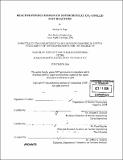Reactor physics design of supercritical CO₂-cooled fast reactors
Author(s)
Pope, Michael A. (Michael Alexander)
DownloadFull printable version (6.988Mb)
Other Contributors
Massachusetts Institute of Technology. Dept. of Nuclear Engineering.
Advisor
Michael J. Driscoll.
Terms of use
Metadata
Show full item recordAbstract
Gas-Cooled Fast Reactors (GFRs) are among the GEN-IV designs proposed for future deployment. Driven by anticipated plant cost reduction, the use of supercritical CO₂ (S-CO₂) as a Brayton cycle working fluid in a direct cycle is evaluated. By using S- CO₂ at turbine inlet conditions of 20 MPa and 550⁰C - 700⁰C, efficiencies between 45% and 50% can be achieved with extremely compact components. Neutronic evaluation of candidate core materials was performed for potential use in block-type matrix fueled GFRs with particular concentration on lowering coolant void reactivity to less than $1. SiC cercer fuel was found to have relatively low coolant void worth (+22 cents upon complete depressurization of S-CO₂ coolant) and tolerable reactivity- limited burnup at matrix volume fractions of 60% or less in a 600 MWth core having H/D of 0.85 and titanium reflectors. Pin-type cores were also evaluated and demonstrated higher kff versus burnup, and higher coolant void reactivity than the SiC cercer cores (+$2.00 in ODS MA956-clad case having H/D of 1). (cont.) It was shown, however, that S-CO₂ coolant void reactivity could be lowered significantly - to less than $1 - in pin cores by increasing neutron leakage (e.g. lowering the core H/D ratio to 0.625 in a pin core with ODS MA956 cladding), an effect not observed in cores using helium coolant at 8 MPa and 500⁰C. An innovative "block"-geometry tube-in-duct fuel consisting of canisters of vibrationally compacted (VIPAC) oxide fuel was introduced and some preliminary calculations were performed. A reference tube-in-duct core was shown to exhibit favorable neutron economy with a conversion ratio (CR) at beginning of life (BOL) of 1.37, but had a coolant void reactivity of +$ 1.4. The high CR should allow designers to lower coolant void worth by increasing leakage while preserving the ability of the core to reach high burnup. Titanium, vanadium and scandium were found to be excellent reflector materials from the standpoint of ... and coolant void reactivity due to their unique elastic scattering cross-section profiles: for example, the SiC cercer core having void reactivity of +$0.22 with titanium was shown to have +$0.57 with Zr₃Si₂. (cont.) Overall, present work confirmed that the S-CO₂-cooled GFR concept has promising characteristics and a sufficiently broad opion space such that a safe and competitive design could be developed in future work with considerably less than $1 void reactivity and a controllable [delta]k due to burnup.
Description
Thesis (S.M.)--Massachusetts Institute of Technology, Dept. of Nuclear Engineering, 2004. Includes bibliographical references (p. 109-113).
Date issued
2004Department
Massachusetts Institute of Technology. Department of Nuclear Engineering; Massachusetts Institute of Technology. Department of Nuclear Science and EngineeringPublisher
Massachusetts Institute of Technology
Keywords
Nuclear Engineering.